Curriculum Planning: Child Observations & Assessment Report
VerifiedAdded on 2023/06/13
|25
|5683
|381
Report
AI Summary
This report provides a detailed overview of curriculum planning, focusing on the observation and assessment of three children aged between 12 to 17 months. It includes written consent forms, child information sheets, and two observations for each child, detailing their behavior, learning styles, strengths, and interests. The observations cover children from Christian, Hindu, and Islamic backgrounds, highlighting the importance of cultural and religious considerations in curriculum planning. A developmental milestone planning guide and a summative assessment summary are also included, offering insights into each child's progress and development. The report emphasizes the significance of understanding individual differences and tailoring educational activities to meet the specific needs of each child.
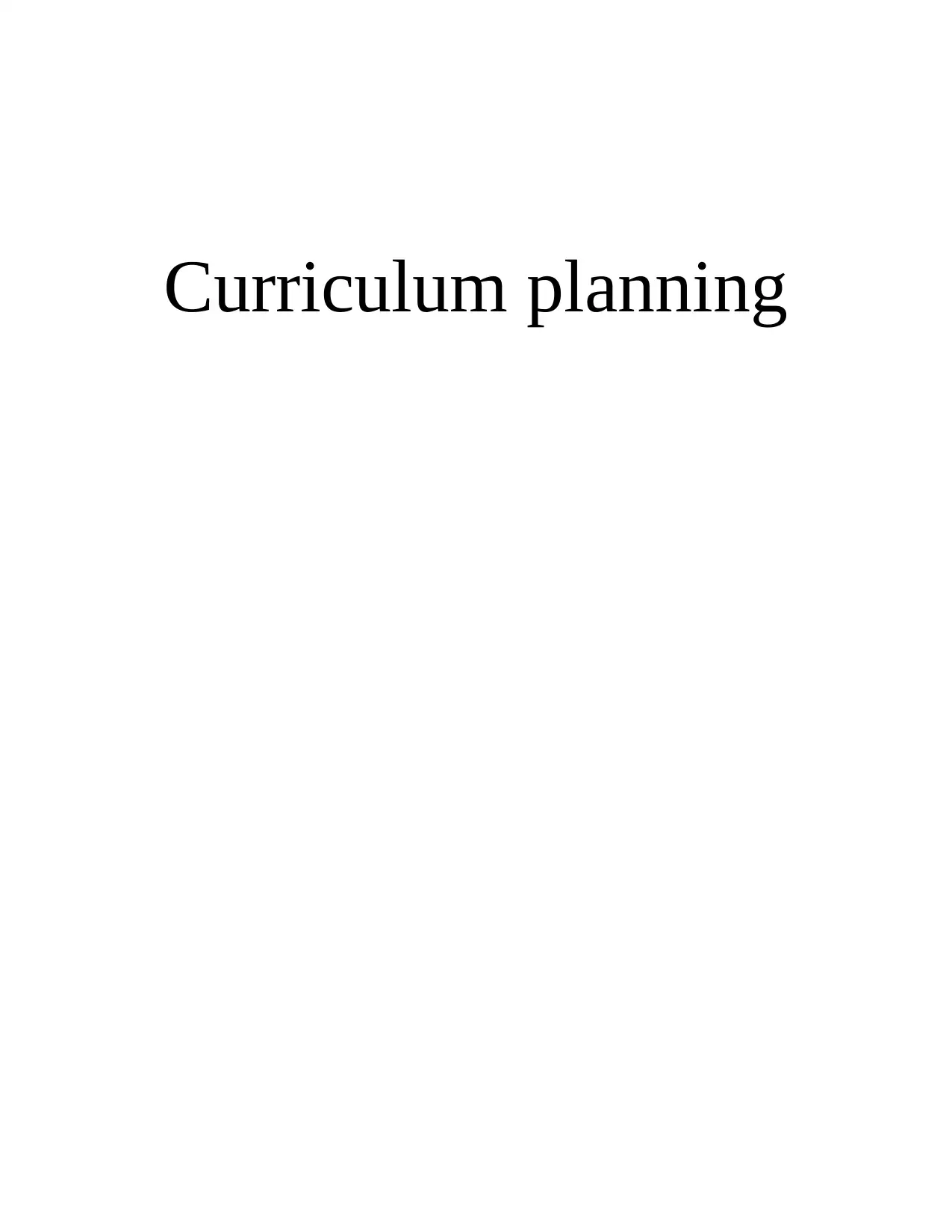
Curriculum planning
Paraphrase This Document
Need a fresh take? Get an instant paraphrase of this document with our AI Paraphraser

Table of Contents
INTRODUCTION...........................................................................................................................1
MAIN BODY...................................................................................................................................1
1: Observation of each children..............................................................................................1
2: Written permission of consent form...................................................................................2
3: Child information of the three children..............................................................................5
4: Two observation of each child...........................................................................................8
Developmental Milestone Planning Guide and one other type of observation record for each
child......................................................................................................................................10
5: Summative assessment summary.....................................................................................17
CONCLUSION..............................................................................................................................22
INTRODUCTION...........................................................................................................................1
MAIN BODY...................................................................................................................................1
1: Observation of each children..............................................................................................1
2: Written permission of consent form...................................................................................2
3: Child information of the three children..............................................................................5
4: Two observation of each child...........................................................................................8
Developmental Milestone Planning Guide and one other type of observation record for each
child......................................................................................................................................10
5: Summative assessment summary.....................................................................................17
CONCLUSION..............................................................................................................................22
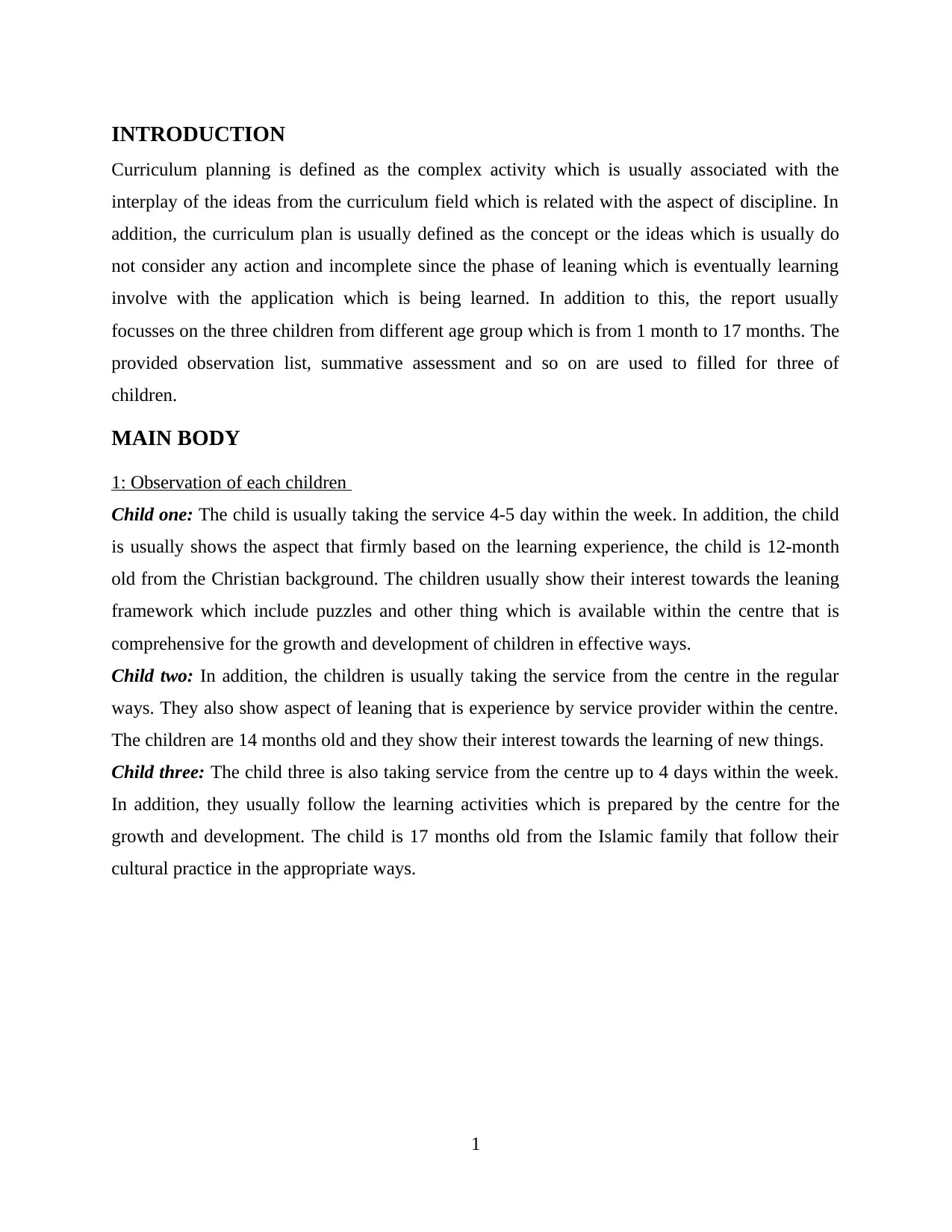
INTRODUCTION
Curriculum planning is defined as the complex activity which is usually associated with the
interplay of the ideas from the curriculum field which is related with the aspect of discipline. In
addition, the curriculum plan is usually defined as the concept or the ideas which is usually do
not consider any action and incomplete since the phase of leaning which is eventually learning
involve with the application which is being learned. In addition to this, the report usually
focusses on the three children from different age group which is from 1 month to 17 months. The
provided observation list, summative assessment and so on are used to filled for three of
children.
MAIN BODY
1: Observation of each children
Child one: The child is usually taking the service 4-5 day within the week. In addition, the child
is usually shows the aspect that firmly based on the learning experience, the child is 12-month
old from the Christian background. The children usually show their interest towards the leaning
framework which include puzzles and other thing which is available within the centre that is
comprehensive for the growth and development of children in effective ways.
Child two: In addition, the children is usually taking the service from the centre in the regular
ways. They also show aspect of leaning that is experience by service provider within the centre.
The children are 14 months old and they show their interest towards the learning of new things.
Child three: The child three is also taking service from the centre up to 4 days within the week.
In addition, they usually follow the learning activities which is prepared by the centre for the
growth and development. The child is 17 months old from the Islamic family that follow their
cultural practice in the appropriate ways.
1
Curriculum planning is defined as the complex activity which is usually associated with the
interplay of the ideas from the curriculum field which is related with the aspect of discipline. In
addition, the curriculum plan is usually defined as the concept or the ideas which is usually do
not consider any action and incomplete since the phase of leaning which is eventually learning
involve with the application which is being learned. In addition to this, the report usually
focusses on the three children from different age group which is from 1 month to 17 months. The
provided observation list, summative assessment and so on are used to filled for three of
children.
MAIN BODY
1: Observation of each children
Child one: The child is usually taking the service 4-5 day within the week. In addition, the child
is usually shows the aspect that firmly based on the learning experience, the child is 12-month
old from the Christian background. The children usually show their interest towards the leaning
framework which include puzzles and other thing which is available within the centre that is
comprehensive for the growth and development of children in effective ways.
Child two: In addition, the children is usually taking the service from the centre in the regular
ways. They also show aspect of leaning that is experience by service provider within the centre.
The children are 14 months old and they show their interest towards the learning of new things.
Child three: The child three is also taking service from the centre up to 4 days within the week.
In addition, they usually follow the learning activities which is prepared by the centre for the
growth and development. The child is 17 months old from the Islamic family that follow their
cultural practice in the appropriate ways.
1
⊘ This is a preview!⊘
Do you want full access?
Subscribe today to unlock all pages.

Trusted by 1+ million students worldwide
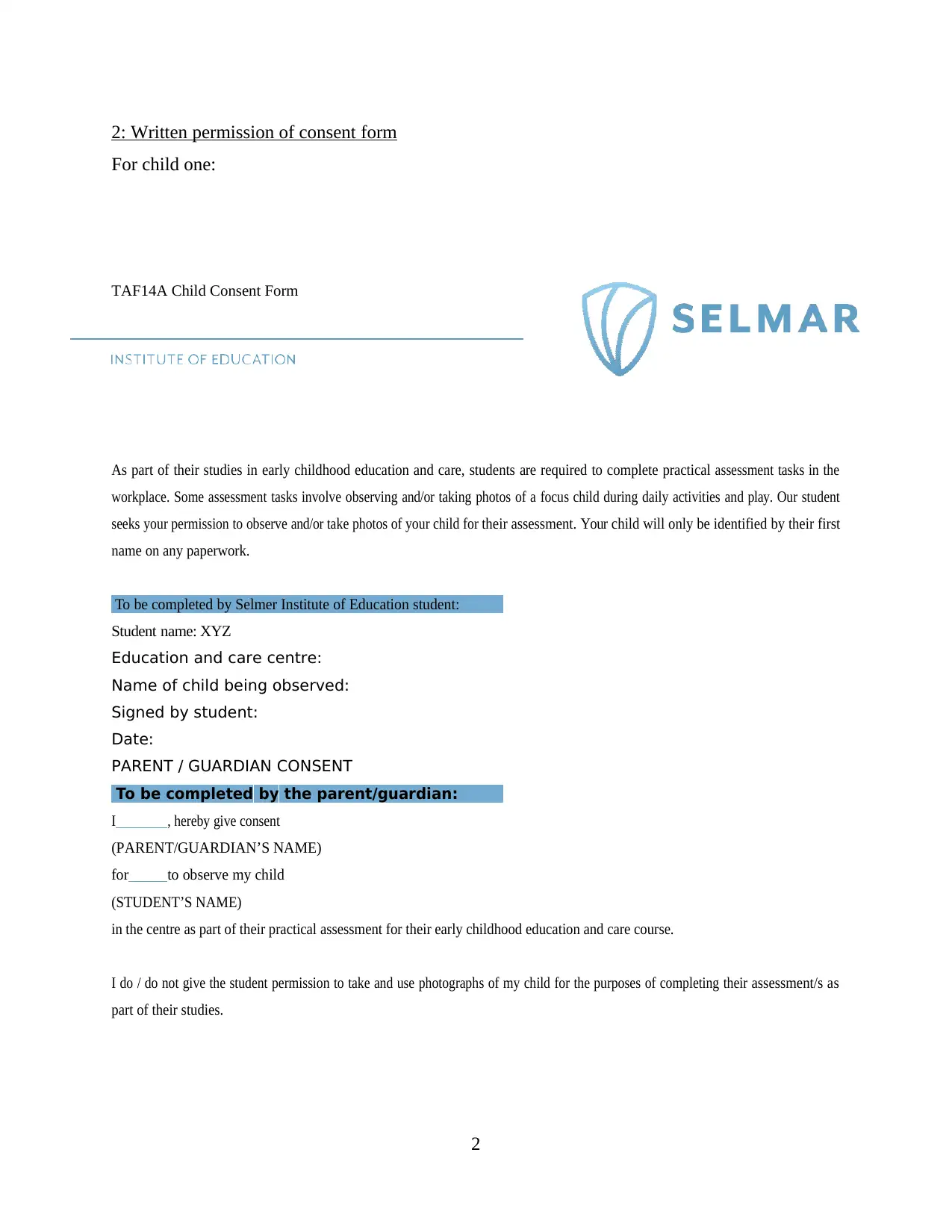
2: Written permission of consent form
For child one:
TAF14A Child Consent Form
As part of their studies in early childhood education and care, students are required to complete practical assessment tasks in the
workplace. Some assessment tasks involve observing and/or taking photos of a focus child during daily activities and play. Our student
seeks your permission to observe and/or take photos of your child for their assessment. Your child will only be identified by their first
name on any paperwork.
To be completed by Selmer Institute of Education student:
Student name: XYZ
Education and care centre:
Name of child being observed:
Signed by student:
Date:
PARENT / GUARDIAN CONSENT
To be completed by the parent/guardian:
I , hereby give consent
(PARENT/GUARDIAN’S NAME)
for to observe my child
(STUDENT’S NAME)
in the centre as part of their practical assessment for their early childhood education and care course.
I do / do not give the student permission to take and use photographs of my child for the purposes of completing their assessment/s as
part of their studies.
2
For child one:
TAF14A Child Consent Form
As part of their studies in early childhood education and care, students are required to complete practical assessment tasks in the
workplace. Some assessment tasks involve observing and/or taking photos of a focus child during daily activities and play. Our student
seeks your permission to observe and/or take photos of your child for their assessment. Your child will only be identified by their first
name on any paperwork.
To be completed by Selmer Institute of Education student:
Student name: XYZ
Education and care centre:
Name of child being observed:
Signed by student:
Date:
PARENT / GUARDIAN CONSENT
To be completed by the parent/guardian:
I , hereby give consent
(PARENT/GUARDIAN’S NAME)
for to observe my child
(STUDENT’S NAME)
in the centre as part of their practical assessment for their early childhood education and care course.
I do / do not give the student permission to take and use photographs of my child for the purposes of completing their assessment/s as
part of their studies.
2
Paraphrase This Document
Need a fresh take? Get an instant paraphrase of this document with our AI Paraphraser

For child two:
TAF14A Child Consent Form
As part of their studies in early childhood education and care, students are required to complete practical assessment tasks in the
workplace. Some assessment tasks involve observing and/or taking photos of a focus child during daily activities and play. Our student
seeks your permission to observe and/or take photos of your child for their assessment. Your child will only be identified by their first
name on any paperwork.
To be completed by Selmer Institute of Education student:
Student name: ABC
Education and care centre:
Name of child being observed:
Signed by student:
Date:
PARENT / GUARDIAN CONSENT
To be completed by the parent/guardian:
I , hereby give consent
(PARENT/GUARDIAN’S NAME)
for to observe my child
(STUDENT’S NAME)
in the centre as part of their practical assessment for their early childhood education and care course.
I do / do not give the student permission to take and use photographs of my child for the purposes of completing their assessment/s as
part of their studies.
3
TAF14A Child Consent Form
As part of their studies in early childhood education and care, students are required to complete practical assessment tasks in the
workplace. Some assessment tasks involve observing and/or taking photos of a focus child during daily activities and play. Our student
seeks your permission to observe and/or take photos of your child for their assessment. Your child will only be identified by their first
name on any paperwork.
To be completed by Selmer Institute of Education student:
Student name: ABC
Education and care centre:
Name of child being observed:
Signed by student:
Date:
PARENT / GUARDIAN CONSENT
To be completed by the parent/guardian:
I , hereby give consent
(PARENT/GUARDIAN’S NAME)
for to observe my child
(STUDENT’S NAME)
in the centre as part of their practical assessment for their early childhood education and care course.
I do / do not give the student permission to take and use photographs of my child for the purposes of completing their assessment/s as
part of their studies.
3
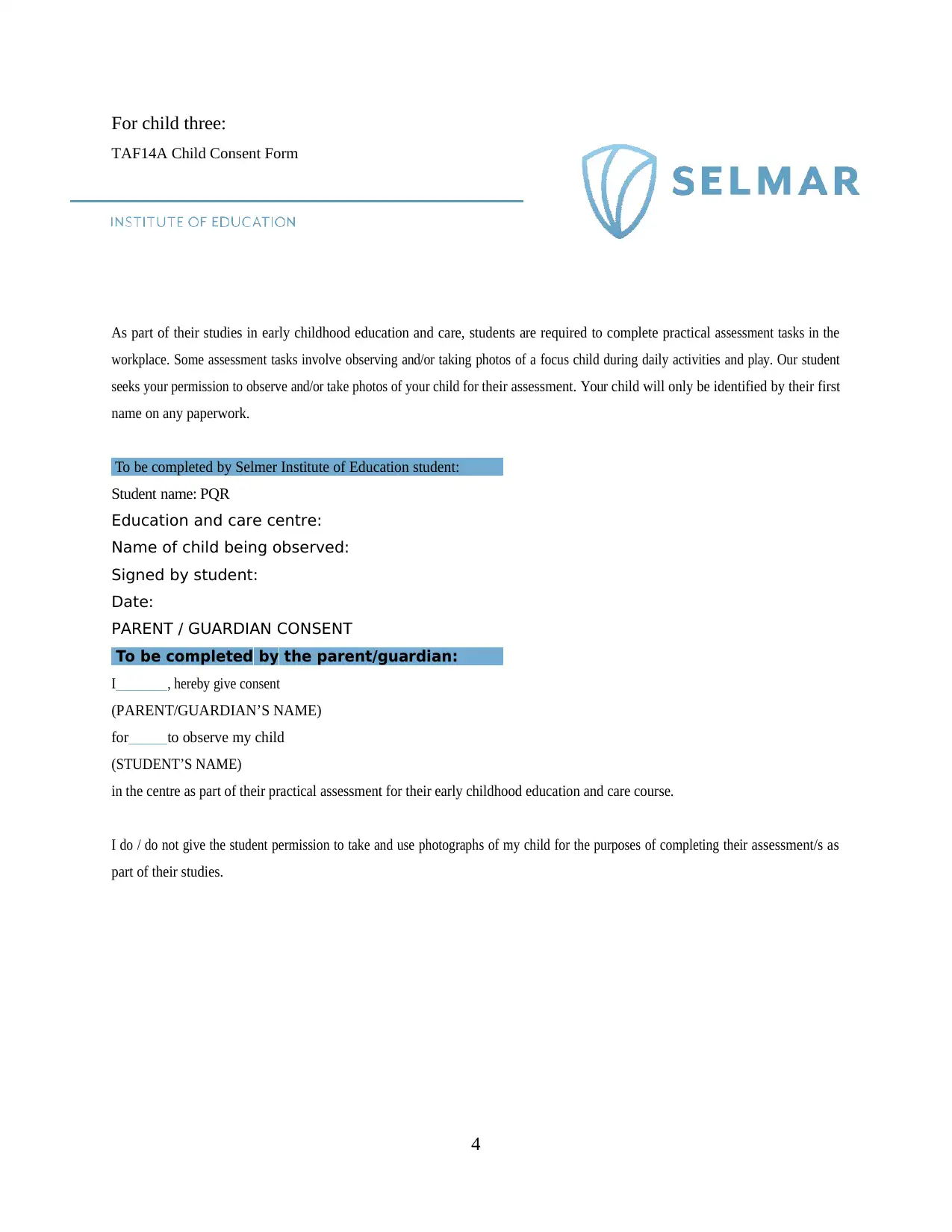
For child three:
TAF14A Child Consent Form
As part of their studies in early childhood education and care, students are required to complete practical assessment tasks in the
workplace. Some assessment tasks involve observing and/or taking photos of a focus child during daily activities and play. Our student
seeks your permission to observe and/or take photos of your child for their assessment. Your child will only be identified by their first
name on any paperwork.
To be completed by Selmer Institute of Education student:
Student name: PQR
Education and care centre:
Name of child being observed:
Signed by student:
Date:
PARENT / GUARDIAN CONSENT
To be completed by the parent/guardian:
I , hereby give consent
(PARENT/GUARDIAN’S NAME)
for to observe my child
(STUDENT’S NAME)
in the centre as part of their practical assessment for their early childhood education and care course.
I do / do not give the student permission to take and use photographs of my child for the purposes of completing their assessment/s as
part of their studies.
4
TAF14A Child Consent Form
As part of their studies in early childhood education and care, students are required to complete practical assessment tasks in the
workplace. Some assessment tasks involve observing and/or taking photos of a focus child during daily activities and play. Our student
seeks your permission to observe and/or take photos of your child for their assessment. Your child will only be identified by their first
name on any paperwork.
To be completed by Selmer Institute of Education student:
Student name: PQR
Education and care centre:
Name of child being observed:
Signed by student:
Date:
PARENT / GUARDIAN CONSENT
To be completed by the parent/guardian:
I , hereby give consent
(PARENT/GUARDIAN’S NAME)
for to observe my child
(STUDENT’S NAME)
in the centre as part of their practical assessment for their early childhood education and care course.
I do / do not give the student permission to take and use photographs of my child for the purposes of completing their assessment/s as
part of their studies.
4
⊘ This is a preview!⊘
Do you want full access?
Subscribe today to unlock all pages.

Trusted by 1+ million students worldwide
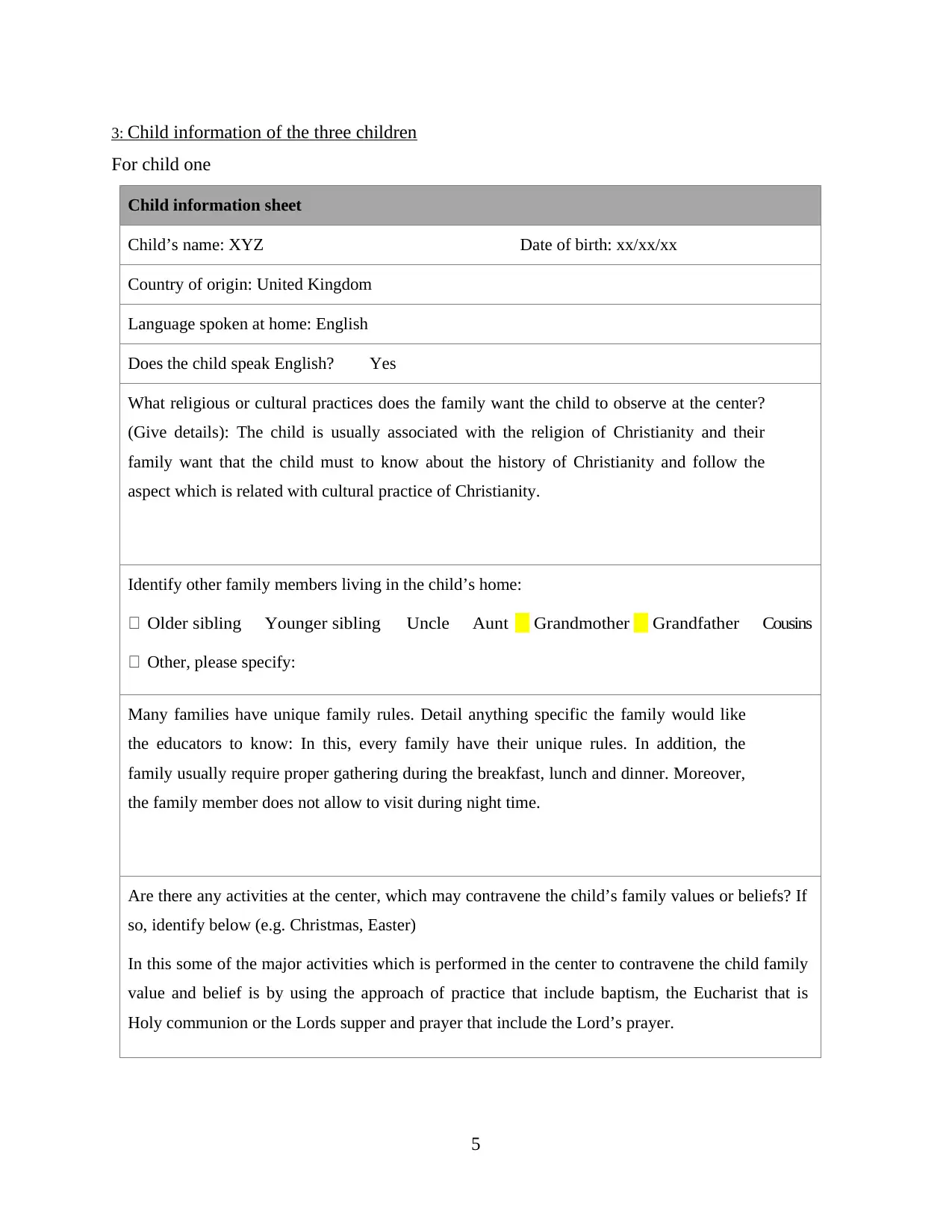
3: Child information of the three children
For child one
Child information sheet
Child’s name: XYZ Date of birth: xx/xx/xx
Country of origin: United Kingdom
Language spoken at home: English
Does the child speak English? Yes
What religious or cultural practices does the family want the child to observe at the center?
(Give details): The child is usually associated with the religion of Christianity and their
family want that the child must to know about the history of Christianity and follow the
aspect which is related with cultural practice of Christianity.
Identify other family members living in the child’s home:
Older sibling Younger sibling Uncle Aunt Grandmother Grandfather Cousins
Other, please specify:
Many families have unique family rules. Detail anything specific the family would like
the educators to know: In this, every family have their unique rules. In addition, the
family usually require proper gathering during the breakfast, lunch and dinner. Moreover,
the family member does not allow to visit during night time.
Are there any activities at the center, which may contravene the child’s family values or beliefs? If
so, identify below (e.g. Christmas, Easter)
In this some of the major activities which is performed in the center to contravene the child family
value and belief is by using the approach of practice that include baptism, the Eucharist that is
Holy communion or the Lords supper and prayer that include the Lord’s prayer.
5
For child one
Child information sheet
Child’s name: XYZ Date of birth: xx/xx/xx
Country of origin: United Kingdom
Language spoken at home: English
Does the child speak English? Yes
What religious or cultural practices does the family want the child to observe at the center?
(Give details): The child is usually associated with the religion of Christianity and their
family want that the child must to know about the history of Christianity and follow the
aspect which is related with cultural practice of Christianity.
Identify other family members living in the child’s home:
Older sibling Younger sibling Uncle Aunt Grandmother Grandfather Cousins
Other, please specify:
Many families have unique family rules. Detail anything specific the family would like
the educators to know: In this, every family have their unique rules. In addition, the
family usually require proper gathering during the breakfast, lunch and dinner. Moreover,
the family member does not allow to visit during night time.
Are there any activities at the center, which may contravene the child’s family values or beliefs? If
so, identify below (e.g. Christmas, Easter)
In this some of the major activities which is performed in the center to contravene the child family
value and belief is by using the approach of practice that include baptism, the Eucharist that is
Holy communion or the Lords supper and prayer that include the Lord’s prayer.
5
Paraphrase This Document
Need a fresh take? Get an instant paraphrase of this document with our AI Paraphraser

Provide any other relevant information about the child: The child is usually focus on the different
play activities. They usually identify the animal’s puzzles and try recognize the faces within home.
For child two
Child information sheet
Child’s name: ABC Date of birth: xx/xx/xx
Country of origin: United Kingdom
Language spoken at home: English
Does the child speak English? Yes No
What religious or cultural practices does the family want the child to observe at the center?
(Give details): The child is related with the religion of Hinduism that focus on the different
cultural practice which is wanted by family within the center. In addition, family want that
the children must aware about the prayers and symbols which is dignify the cultural practice.
Identify other family members living in the child’s home:
Older sibling Younger sibling Uncle Aunt Grandmother Grandfather Cousins
Other, please specify:
Many families have unique family rules. Detail anything specific the family would like
the educators to know: The family is usually working and they do not focus on the
children growth and develop. Child is usually learning from center.
6
play activities. They usually identify the animal’s puzzles and try recognize the faces within home.
For child two
Child information sheet
Child’s name: ABC Date of birth: xx/xx/xx
Country of origin: United Kingdom
Language spoken at home: English
Does the child speak English? Yes No
What religious or cultural practices does the family want the child to observe at the center?
(Give details): The child is related with the religion of Hinduism that focus on the different
cultural practice which is wanted by family within the center. In addition, family want that
the children must aware about the prayers and symbols which is dignify the cultural practice.
Identify other family members living in the child’s home:
Older sibling Younger sibling Uncle Aunt Grandmother Grandfather Cousins
Other, please specify:
Many families have unique family rules. Detail anything specific the family would like
the educators to know: The family is usually working and they do not focus on the
children growth and develop. Child is usually learning from center.
6
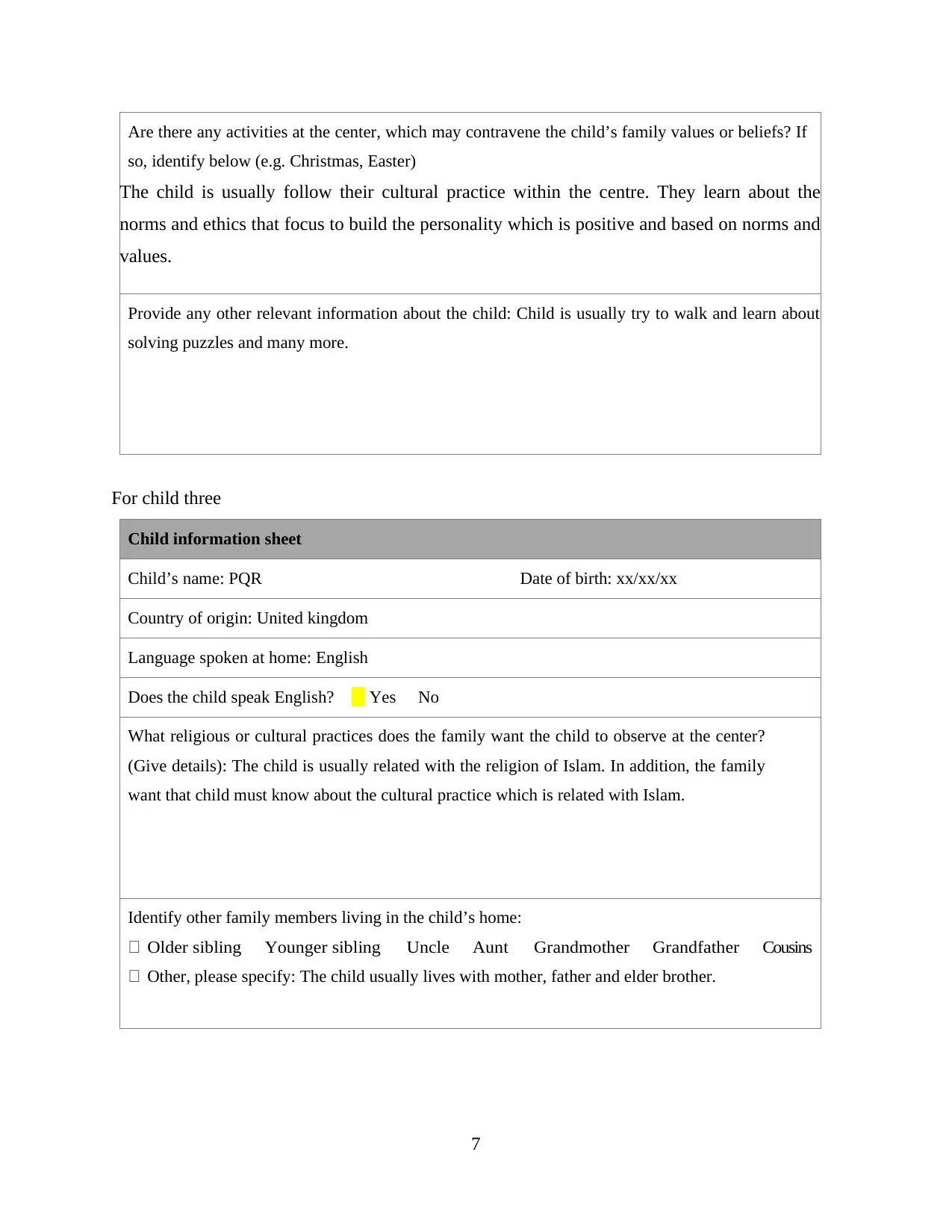
Are there any activities at the center, which may contravene the child’s family values or beliefs? If
so, identify below (e.g. Christmas, Easter)
The child is usually follow their cultural practice within the centre. They learn about the
norms and ethics that focus to build the personality which is positive and based on norms and
values.
Provide any other relevant information about the child: Child is usually try to walk and learn about
solving puzzles and many more.
For child three
Child information sheet
Child’s name: PQR Date of birth: xx/xx/xx
Country of origin: United kingdom
Language spoken at home: English
Does the child speak English? Yes No
What religious or cultural practices does the family want the child to observe at the center?
(Give details): The child is usually related with the religion of Islam. In addition, the family
want that child must know about the cultural practice which is related with Islam.
Identify other family members living in the child’s home:
Older sibling Younger sibling Uncle Aunt Grandmother Grandfather Cousins
Other, please specify: The child usually lives with mother, father and elder brother.
7
so, identify below (e.g. Christmas, Easter)
The child is usually follow their cultural practice within the centre. They learn about the
norms and ethics that focus to build the personality which is positive and based on norms and
values.
Provide any other relevant information about the child: Child is usually try to walk and learn about
solving puzzles and many more.
For child three
Child information sheet
Child’s name: PQR Date of birth: xx/xx/xx
Country of origin: United kingdom
Language spoken at home: English
Does the child speak English? Yes No
What religious or cultural practices does the family want the child to observe at the center?
(Give details): The child is usually related with the religion of Islam. In addition, the family
want that child must know about the cultural practice which is related with Islam.
Identify other family members living in the child’s home:
Older sibling Younger sibling Uncle Aunt Grandmother Grandfather Cousins
Other, please specify: The child usually lives with mother, father and elder brother.
7
⊘ This is a preview!⊘
Do you want full access?
Subscribe today to unlock all pages.

Trusted by 1+ million students worldwide

Many families have unique family rules. Detail anything specific the family would like
the educators to know: They are very strict regards with the cultural practice and they
pray for at least five time a day. In this, they have set of rules that the all family member
is usually take their food together and share their opinion and though regards with any
issue.
Are there any activities at the center, which may contravene the child’s family values or beliefs? If
so, identify below (e.g. Christmas, Easter)
Profession of faith
Prayer
Alms
Provide any other relevant information about the child: Child is usually concern regarding with the
family and their cultural aspect.
4: Two observation of each child
Child one:
Observation 1: Behaviour and learning
While taking the contrast of child one who is from Christian background usually play
more than other as compared to the child of centre. In addition, the behaviour is optimistic and
used to interact with number of people with any hesitation. Moreover, the child usually shows
their aspect in learning of new things which is recommended for him. Child take long sleep in
afternoon that may be help him to provide relaxation due to the snap. Therefore, the child is full
of curiosity and used to take with the interest to learn about the new thing. Child follow some of
the behaviour which is interactive towards other when someone talk or used to deliver story then
child listen in predominant ways.
Observation 2: Strength and interest
The child has major strength that is related with communication and interaction in the
friendly in their first meeting. Therefore, other associated strength is learning and showing the
8
the educators to know: They are very strict regards with the cultural practice and they
pray for at least five time a day. In this, they have set of rules that the all family member
is usually take their food together and share their opinion and though regards with any
issue.
Are there any activities at the center, which may contravene the child’s family values or beliefs? If
so, identify below (e.g. Christmas, Easter)
Profession of faith
Prayer
Alms
Provide any other relevant information about the child: Child is usually concern regarding with the
family and their cultural aspect.
4: Two observation of each child
Child one:
Observation 1: Behaviour and learning
While taking the contrast of child one who is from Christian background usually play
more than other as compared to the child of centre. In addition, the behaviour is optimistic and
used to interact with number of people with any hesitation. Moreover, the child usually shows
their aspect in learning of new things which is recommended for him. Child take long sleep in
afternoon that may be help him to provide relaxation due to the snap. Therefore, the child is full
of curiosity and used to take with the interest to learn about the new thing. Child follow some of
the behaviour which is interactive towards other when someone talk or used to deliver story then
child listen in predominant ways.
Observation 2: Strength and interest
The child has major strength that is related with communication and interaction in the
friendly in their first meeting. Therefore, other associated strength is learning and showing the
8
Paraphrase This Document
Need a fresh take? Get an instant paraphrase of this document with our AI Paraphraser
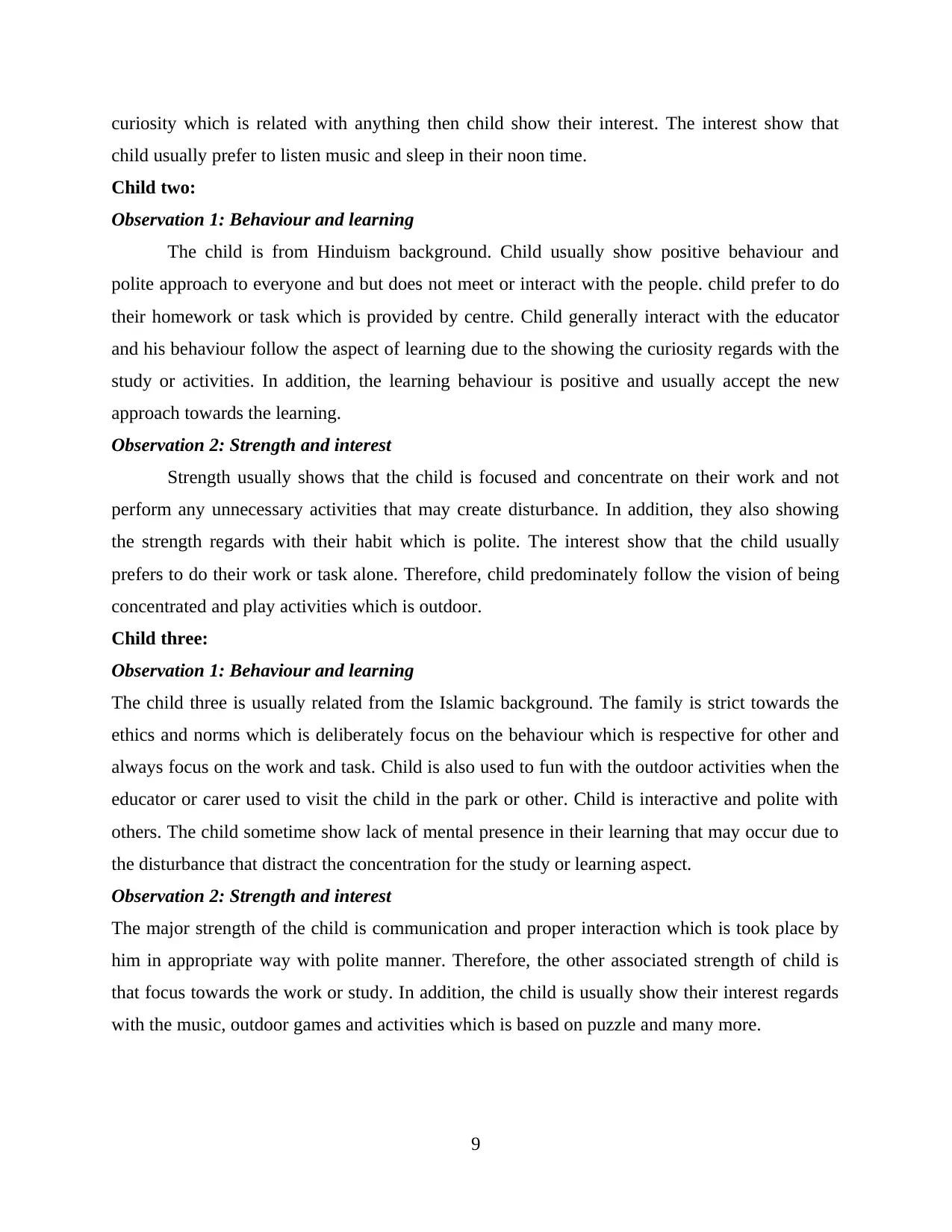
curiosity which is related with anything then child show their interest. The interest show that
child usually prefer to listen music and sleep in their noon time.
Child two:
Observation 1: Behaviour and learning
The child is from Hinduism background. Child usually show positive behaviour and
polite approach to everyone and but does not meet or interact with the people. child prefer to do
their homework or task which is provided by centre. Child generally interact with the educator
and his behaviour follow the aspect of learning due to the showing the curiosity regards with the
study or activities. In addition, the learning behaviour is positive and usually accept the new
approach towards the learning.
Observation 2: Strength and interest
Strength usually shows that the child is focused and concentrate on their work and not
perform any unnecessary activities that may create disturbance. In addition, they also showing
the strength regards with their habit which is polite. The interest show that the child usually
prefers to do their work or task alone. Therefore, child predominately follow the vision of being
concentrated and play activities which is outdoor.
Child three:
Observation 1: Behaviour and learning
The child three is usually related from the Islamic background. The family is strict towards the
ethics and norms which is deliberately focus on the behaviour which is respective for other and
always focus on the work and task. Child is also used to fun with the outdoor activities when the
educator or carer used to visit the child in the park or other. Child is interactive and polite with
others. The child sometime show lack of mental presence in their learning that may occur due to
the disturbance that distract the concentration for the study or learning aspect.
Observation 2: Strength and interest
The major strength of the child is communication and proper interaction which is took place by
him in appropriate way with polite manner. Therefore, the other associated strength of child is
that focus towards the work or study. In addition, the child is usually show their interest regards
with the music, outdoor games and activities which is based on puzzle and many more.
9
child usually prefer to listen music and sleep in their noon time.
Child two:
Observation 1: Behaviour and learning
The child is from Hinduism background. Child usually show positive behaviour and
polite approach to everyone and but does not meet or interact with the people. child prefer to do
their homework or task which is provided by centre. Child generally interact with the educator
and his behaviour follow the aspect of learning due to the showing the curiosity regards with the
study or activities. In addition, the learning behaviour is positive and usually accept the new
approach towards the learning.
Observation 2: Strength and interest
Strength usually shows that the child is focused and concentrate on their work and not
perform any unnecessary activities that may create disturbance. In addition, they also showing
the strength regards with their habit which is polite. The interest show that the child usually
prefers to do their work or task alone. Therefore, child predominately follow the vision of being
concentrated and play activities which is outdoor.
Child three:
Observation 1: Behaviour and learning
The child three is usually related from the Islamic background. The family is strict towards the
ethics and norms which is deliberately focus on the behaviour which is respective for other and
always focus on the work and task. Child is also used to fun with the outdoor activities when the
educator or carer used to visit the child in the park or other. Child is interactive and polite with
others. The child sometime show lack of mental presence in their learning that may occur due to
the disturbance that distract the concentration for the study or learning aspect.
Observation 2: Strength and interest
The major strength of the child is communication and proper interaction which is took place by
him in appropriate way with polite manner. Therefore, the other associated strength of child is
that focus towards the work or study. In addition, the child is usually show their interest regards
with the music, outdoor games and activities which is based on puzzle and many more.
9
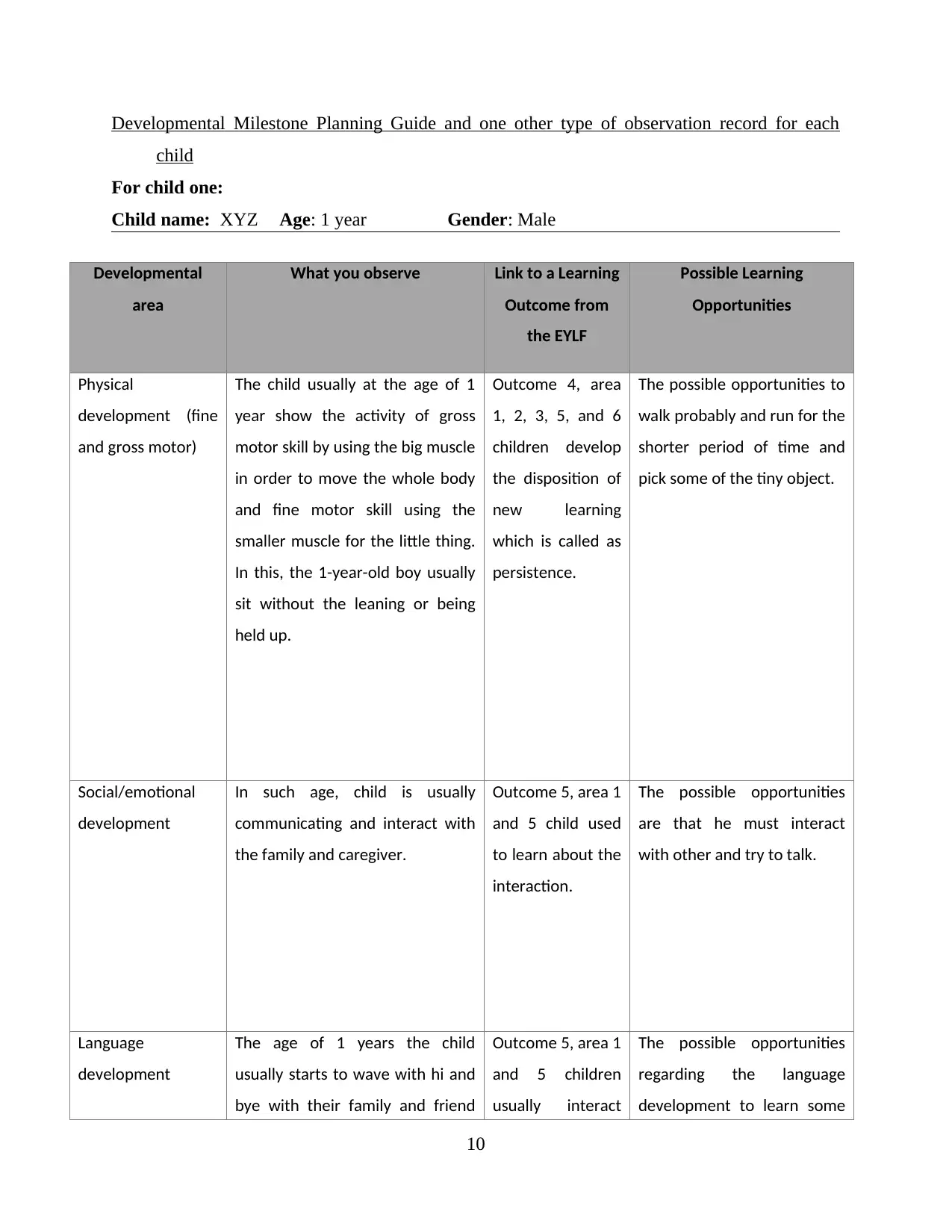
Developmental Milestone Planning Guide and one other type of observation record for each
child
For child one:
Child name: XYZ Age: 1 year Gender: Male
Developmental
area
What you observe Link to a Learning
Outcome from
the EYLF
Possible Learning
Opportunities
Physical
development (fine
and gross motor)
The child usually at the age of 1
year show the activity of gross
motor skill by using the big muscle
in order to move the whole body
and fine motor skill using the
smaller muscle for the little thing.
In this, the 1-year-old boy usually
sit without the leaning or being
held up.
Outcome 4, area
1, 2, 3, 5, and 6
children develop
the disposition of
new learning
which is called as
persistence.
The possible opportunities to
walk probably and run for the
shorter period of time and
pick some of the tiny object.
Social/emotional
development
In such age, child is usually
communicating and interact with
the family and caregiver.
Outcome 5, area 1
and 5 child used
to learn about the
interaction.
The possible opportunities
are that he must interact
with other and try to talk.
Language
development
The age of 1 years the child
usually starts to wave with hi and
bye with their family and friend
Outcome 5, area 1
and 5 children
usually interact
The possible opportunities
regarding the language
development to learn some
10
child
For child one:
Child name: XYZ Age: 1 year Gender: Male
Developmental
area
What you observe Link to a Learning
Outcome from
the EYLF
Possible Learning
Opportunities
Physical
development (fine
and gross motor)
The child usually at the age of 1
year show the activity of gross
motor skill by using the big muscle
in order to move the whole body
and fine motor skill using the
smaller muscle for the little thing.
In this, the 1-year-old boy usually
sit without the leaning or being
held up.
Outcome 4, area
1, 2, 3, 5, and 6
children develop
the disposition of
new learning
which is called as
persistence.
The possible opportunities to
walk probably and run for the
shorter period of time and
pick some of the tiny object.
Social/emotional
development
In such age, child is usually
communicating and interact with
the family and caregiver.
Outcome 5, area 1
and 5 child used
to learn about the
interaction.
The possible opportunities
are that he must interact
with other and try to talk.
Language
development
The age of 1 years the child
usually starts to wave with hi and
bye with their family and friend
Outcome 5, area 1
and 5 children
usually interact
The possible opportunities
regarding the language
development to learn some
10
⊘ This is a preview!⊘
Do you want full access?
Subscribe today to unlock all pages.

Trusted by 1+ million students worldwide
1 out of 25
Related Documents
Your All-in-One AI-Powered Toolkit for Academic Success.
+13062052269
info@desklib.com
Available 24*7 on WhatsApp / Email
![[object Object]](/_next/static/media/star-bottom.7253800d.svg)
Unlock your academic potential
Copyright © 2020–2025 A2Z Services. All Rights Reserved. Developed and managed by ZUCOL.





